A number of relevant new findings that emerged during the course of the scientific activity within the interdisciplinary research project Euploos on the fund of the Gabinetto dei Disegni e delle Stampe degli Uffizi were presented yesterday at the Uffizi, live streamed for the Uffizi on air program: in particular, young scholars Roberta Aliventi and Laura Da Rin Bettina presented a joint research project that, starting from the inventory and collection study of the fund of drawings by Raphael Sanzio (Urbino, 1483 - Rome, 1520), led to an important discovery regarding a cartoon by the Urbinate, recently restored by Maurizio Michelozzi and exhibited for the first time at the major monographic exhibition on Raphael at the Scuderie del Quirinale. In short, a forgotten drawing has once again been attributed to Raphael: the work in question, in fact, turned out to be attributed to Luca Penni (Florence, c. 1500 - Paris, 1556), younger brother of Giovan Francesco who was Raphael’s pupil, although it had previously been assigned to Raphael’s hand.
It is a drawing depicting a Young Woman seated with her arms outstretched toward a child (this is how it was presented at the Quirinale exhibition), first mentioned, with attribution to Raphael, by Karl Morgenstern in 1813. Instead, the attribution to Penni dates from the early 20th century, although in 1925 the scholar Oskar Fischel implicitly suggested Raphael’s authorship, believing it to be a cartoon for the Deesis with Saints Paul and Catherine of Alexandria executed by Giulio Romano (but based on Raphael’s invention) and preserved in Parma. The last mention in critical literature of the cartoon was in 1944, when it was mentioned by Frederick Hartt with attribution to Giovan Francesco Penni. Thereafter, the cartoon was never discussed or exhibited.
“This is a study that has been ongoing for several years,” said Roberta Aliventi, "which has led us to reconstruct in detail an album of Raphael drawings that in the second half of the 17th century was part of the graphic collection of Cardinal Leopoldo de’ Medici. Leopold was one of the greatest collectors of his time, and during his lifetime he acquired countless works belonging to different genres. Dwelling on his collection of drawings, which forms the founding nucleus of the Gabinetto dei Disegni e delle Stampe in the Uffizi Galleries, we know that it consisted of about 12,000 pieces and was arranged in volumes by Filippo Baldinucci, a Florentine gentleman, art historian and connoisseur. These volumes were divided into particulars devoted to the folios of individual artists and into universals, that is, collections and miscellany of works by different masters. These books were dismembered beginning in the early decades of the nineteenth century: one of the most valuable of the entire collection must surely have been the volume called Particular II, in which were kept only drawings by Raphael. And it is precisely this volume that Laura and I have tried to reconstruct in its entirety. To do this we started from the study of archival and inventory documents, we also made use of a text written in the early nineteenth century by Karl Morgenstern, a German philologist who on his trip to Italy paused to describe some of the treasures kept precisely in the Uffizi. In addition, fundamental to our work was a sweeping search of all the folios preserved in the Cabinet that could in some way be linked to Raphael: we therefore examined works classified under the name of the artist himself but also copies, workshop and school drawings. Finally, we looked for all the studies that in past centuries were thought to be by Raphael, but which over time and for various reasons changed author and were placed in the folders of other artists."
The sheet (inventory number 14730 F) was considered among the most interesting of those researched. Because of its placement in the folders of Luca Penni, the drawing has remained unknown to recent critics and is never mentioned in Raphael studies of the second half of the 20th century. Done in charcoal with white lead highlights on a beige tinted support and made from three pieces of paper glued together, it depicts a veiled young woman carrying a hand to her chest. At the time of its discovery, it was in a precarious state of preservation (the woman’s right hand was damaged and clumsily re-glued, and the study was lined with a backing that was itself glued to another sheet). On the occasion of the exhibition at the Rome show, however, the work was restored by Maurizio Michelozzi, who removed the two old backings and the damaged and fragmentary recomposition of the left hand, restoring the sheet to a state as close as possible to its original appearance.
As Fischel had guessed, the work is to be related to the Virgin of the Deesis, produced between 1519 and 1520 in Raphael’s workshop and now unanimously assigned to Giulio Romano. This is not a preliminary study, but the final cartoon, that is, the graphic instrument that was used to transfer the composition to the final support. In this case the drawing was not transferred with the technique of dusting, but with that of engraving: in fact, on the sheet there are the marks left by the stylus (found by a grazing light photograph) to bring the drawing back to the final support. The drawn Virgin also has the same dimensions as the painted one, and even the pose corresponds almost perfectly (the tilt of the head, the bag under the eye). The sheet, according to Aliventi and Da Rin Bettina, is therefore surely a fragment of the cartoon employed by Giulio Romano in the execution of his Deesis.
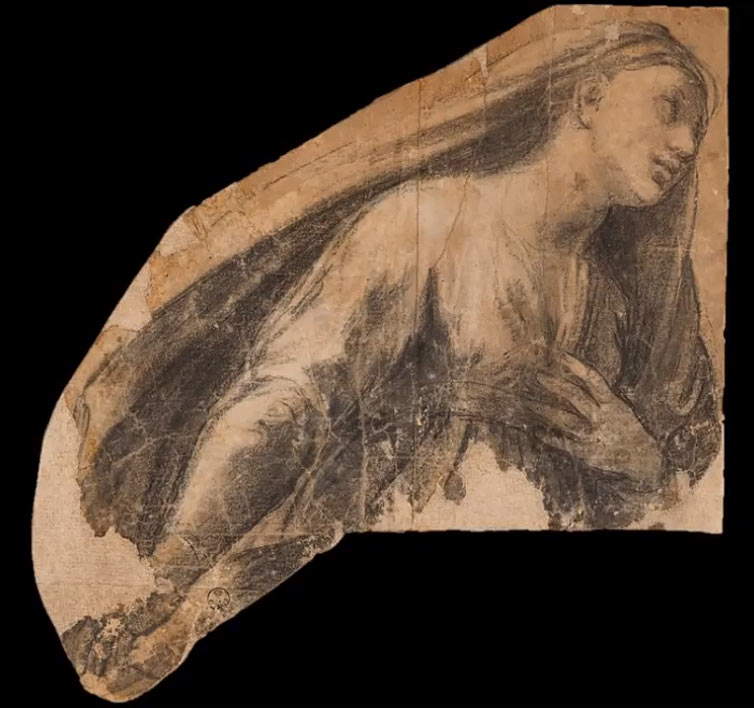 |
| Raphael, Bust of Veiled Young Woman with Hand on Chest (cartoon for Virgin of the Deesis with Saints Paul and Catherine ofAlexandria) (c. 1519-1520; charcoal, white lead, stylus on paper tinted with gray-beige color, 266 �? 264 mm; Florence, Uffizi Gallery, Gabinetto dei Disegni e delle Stampe, inv. 14730 F) |
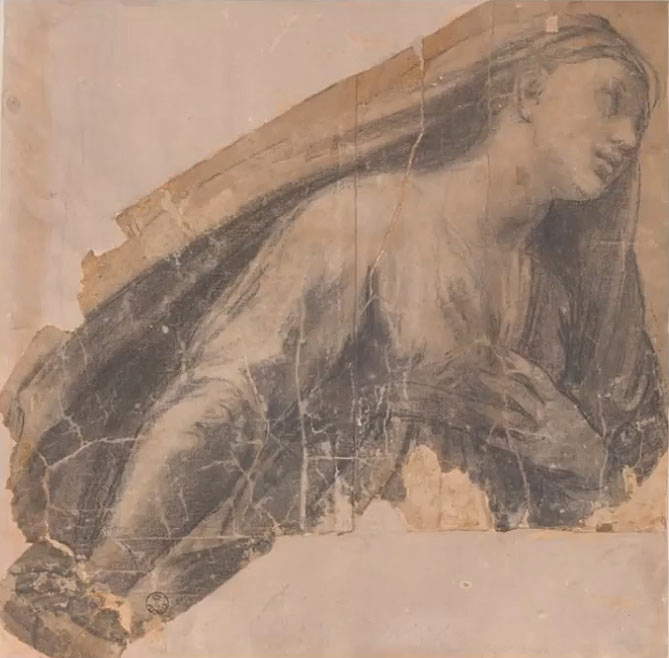 |
| The cartoon before restoration |
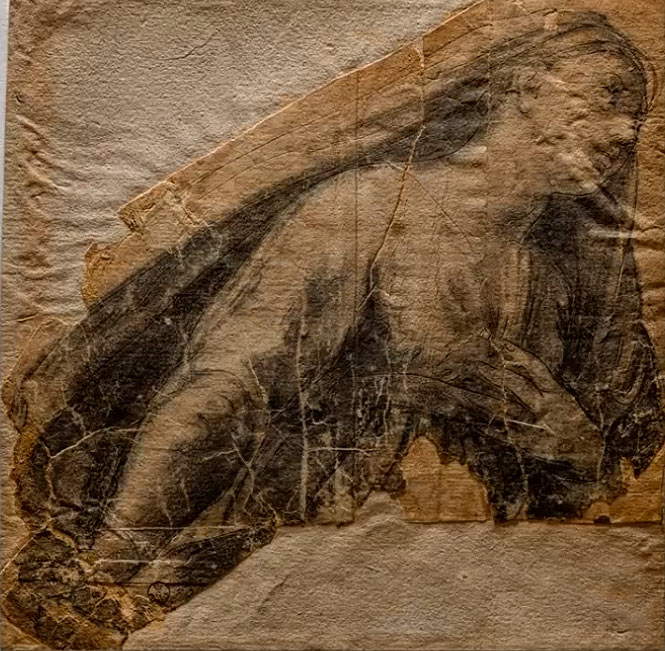 |
| Image of the cartoon in grazing light |
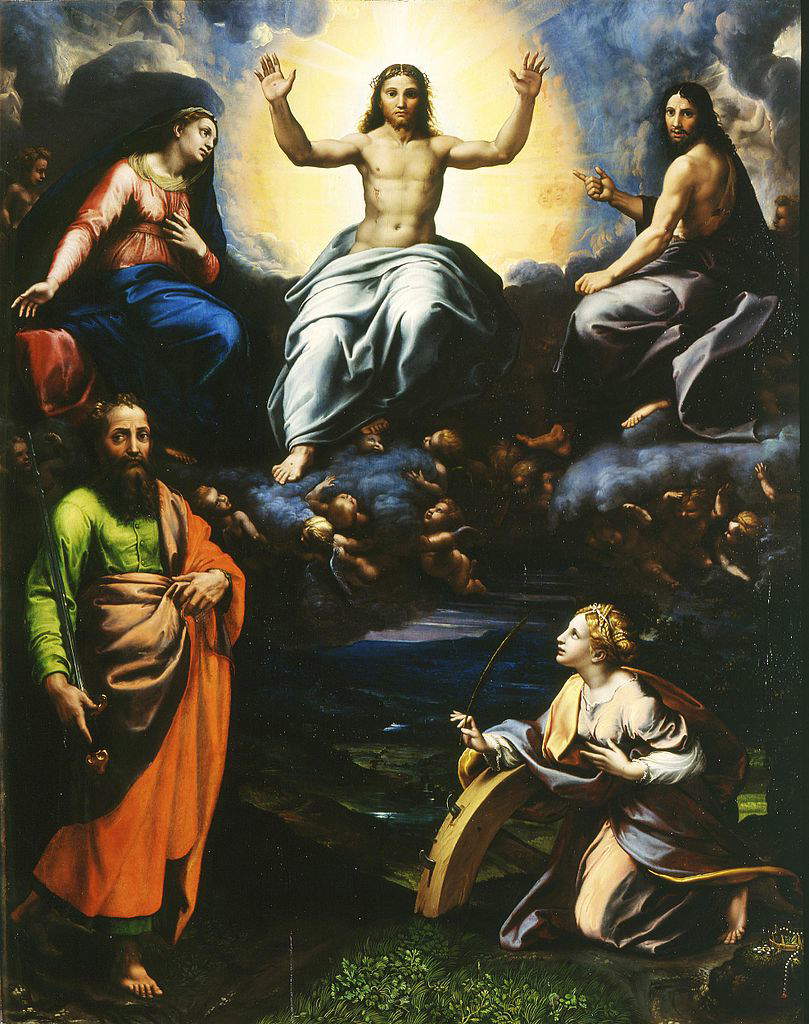 |
| Giulio Romano, Deesis with Saints Paul and Catherine of Alexandria (1519-1520; oil on panel, 122 �? 98 cm; Parma, Galleria Nazionale) |
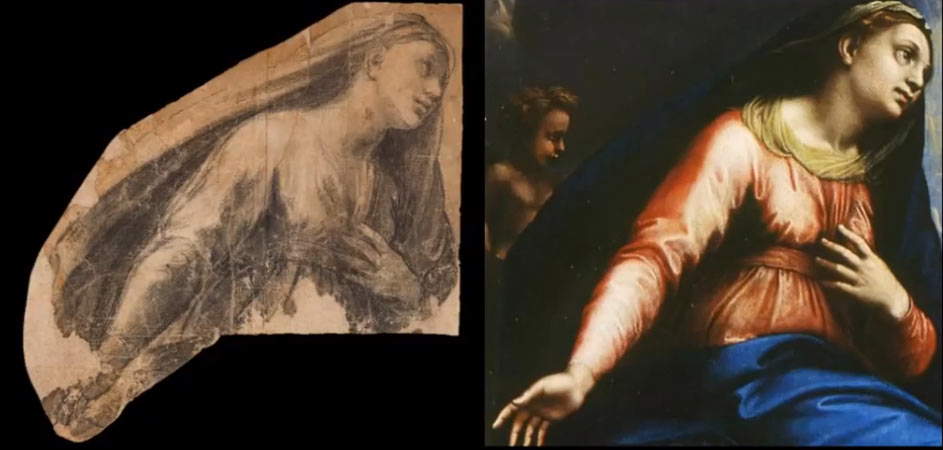 |
| Comparison of the cartoon and the painting |
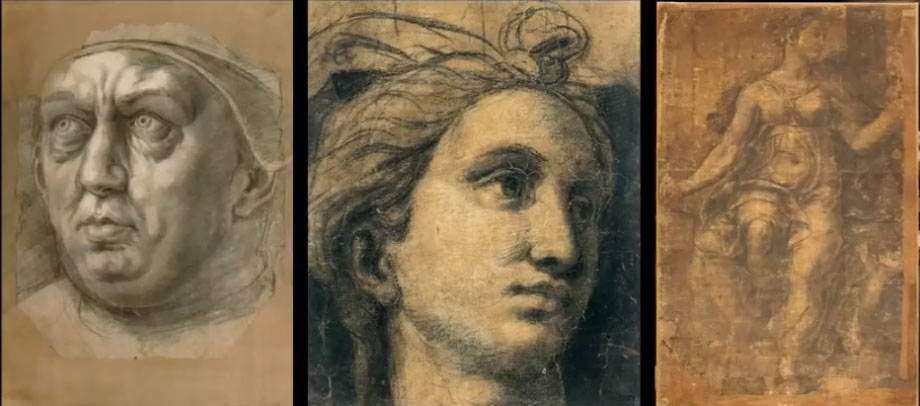 |
| Some fragments of Giulio Romano’s cartoons for the Hall of Constantine |
“In Giulio’s painting,” says Laura Da Rin Bettina, “one of the first things that Roberta and I noticed is how the figure of the Virgin has an expression that to us seemed more hardened and less spontaneous than in the Uffizi drawing, which instead has a more natural and intense expression. This qualitative gap between the graphic and the pictorial solution led us to reflect on the attribution to be given to this drawing, so we first compared it with Giulio Romano’s cartoons close in date to ours, that is, datable around 1519-1520, and sincerely we seemed to notice some not insignificant formal differences with ours.” For example, the cartoons executed by Giulio Romano for the frescoes in the Hall of Constantine in the Vatican (designed by Raphael but substantially executed after his death by his pupils) show "a more sculptural style than that of the Uffizi drawing. Also, in another cartoon by Giulio Romano, the one for the Stoning of St. Stephen preserved in the church of Santo Stefano in Genoa, we see a very sharp and sharp chiaroscuro, thus very different from that of our drawing. The figures depicted are much more three-dimensional and plastic than Raphael’s, and at the same time their movements seem blocked to us. The rendering of the robes and draperies, again very sharp and sharp, seems to us more flattened on the surface, less atmospheric. In contrast, despite its fragmentary character, in our sheet the figure articulates more freely in space and with a certain grace, and is represented with a soft atmospheric charcoal mark. In our view, these stylistic features bring it rather closer to Raphael’s drawings, primarily the Christ in Glory in the Getty Museum, and also to other examples such as the angel’s head that Raphael drew for the Hall of Constantine and that is now in the Museums of Fine Arts in Budapest. Although in several cases it is very difficult to distinguish the hand of the master from that of Giulio Romano, precisely because Giulio Romano is capable of assimilating Raphael’s language by achieving outcomes very close to the master’s manner, in this case it seems appropriate to return this graphic proof, in our opinion of the highest quality, to Raphael, thus recovering the ancient seventeenth-century attribution of the sheet that was kept in the collection of Cardinal Leopold de’ Medici."
The attribution, the two scholars made known, was shared (through oral communication, but of which Aliventi and Da Rin Bettina gave an account in the work’s card in the Uffizi exhibition catalog) by Marzia Faietti and Achim Gnann: the latter, in particular, considers it plausible because the figure of the Virgin appears more convincingly resolved than the painted one, but he nevertheless reserved the right to confirm or not the autograph after direct analysis of the drawing. Finally, the considerations of the two scholars are being published in the proceedings of the conference Marcantonio Raimondi. Raphael’s first engraver, held in Urbino’s Palazzo Albani between October 23 and 25, 2019, and as part of which the discovery was first reported.
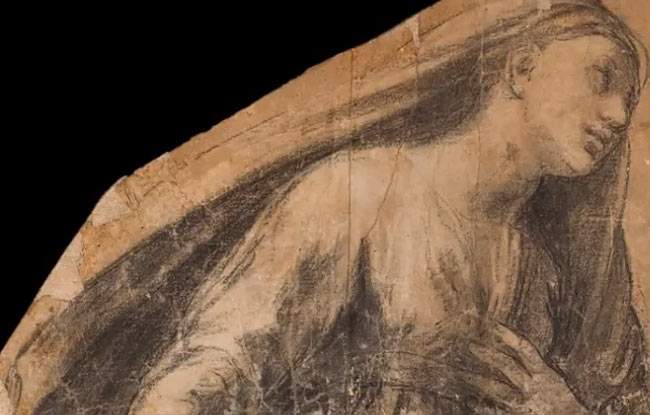 |
| A "new" Raphael at the Uffizi: the rediscovery of a forgotten drawing by Urbino |
Warning: the translation into English of the original Italian article was created using automatic tools. We undertake to review all articles, but we do not guarantee the total absence of inaccuracies in the translation due to the program. You can find the original by clicking on the ITA button. If you find any mistake,please contact us.